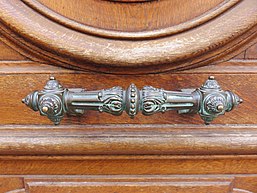Knowledge, Information and Experience
Handles were mainly invented for making it easy for people to make the movements of the door…
The traditional door knob has a bolt or spindle running through it that sits just above a cylinder, to which the spindle is connected. Turning the knob pulls the cylinder in the direction of the turn. The end of the cylinder is the “latch bolt” (more simply known as the “latch”), which protrudes into a space carved out of the door frame, and which prevents the door from being opened if the knob is not turned. A spring or similar mechanism causes the latch to return to its protruding state whenever the knob is not being turned. escutcheon plates are the keyhole covers, usually circular, through which keys pass to enter the lock body. If the door handles have a square or rectangular plate on which the handle is mounted this is called the backplate. The plate on the front edge of the lock where the latch bolt protrudes is called the faceplate.
Before door knobs and handles were invented, people used locks to keep a door shut. Only the wealthy could afford a lock and key, however. Poorer people used a latch-string, making a small hole in a door and threading a leather thong or string through, which could then be looped around a wooden bar.
The first patent was given for a locking door knob in 1878 to an African American inventor called Osborn Dorsey.
Today the fundamental design of handles and knobs hasn’t changed much from this period. From basic pulls to more sophisticated 5-lever locks; modern chrome to traditional designs, a door handle today is more than simple functionality.
Here is a quick timeline of door history:
Ancient Egyptian period (from approx 3000 BC) has art depicting doors made out of slabs of wood and cloth hangings. We can also thank the ancient Egyptians for the invention of the door lock – the basic pin tumbler lock still in use today – which they made entirely out of wood.
King Solomon (970 – 931 BC) had temple doors made from olive wood.
Greek & Roman civilisations, uncovered by archeologists, used door hinges very similar to those used today. There are Roman door hinges made from bronze in the British Museum.
Middle Ages (500-1500 AD) saw people generally living in one big room with little need for internal doors. But for safety from raiding soldiers households secured themselves and their belongings by barring the external doorway with heavy beams of oak. During the day doors were left open to allow for ventilation for fires and cooking. Locks were not in general use during this period due to expense.
From the late 1500’s, the Royals and wealthy gentry built palaces and homes with individual rooms. Doors for privacy were made from woven tapestries initially, and then wooden doors came into general use, hung from basic hand-forged strap hinges with bolts fixed into stonework.
Comparing it with real life, we can learn that as handles make it convenient for us to handle the doors, we should be able to handle any situation easily and tactfully.
Tags: Surrender










